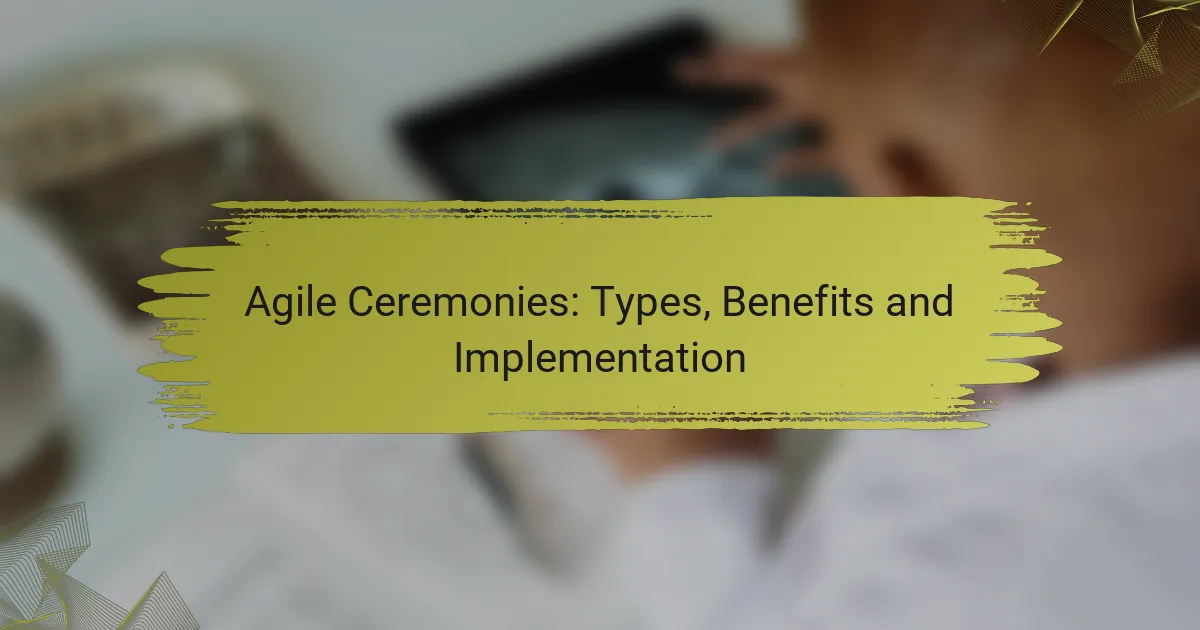Agile ceremonies are essential structured meetings that promote collaboration and communication within Agile teams, enabling them to plan, execute, and reflect on their work effectively. By incorporating these ceremonies, teams can foster a culture of continuous improvement and adaptability, ultimately enhancing project outcomes. Successful implementation requires a focus on clear objectives, regular schedules, and open communication to boost collaboration and productivity.

What are the types of Agile ceremonies?
Agile ceremonies are structured meetings that facilitate collaboration and communication within Agile teams. They include key activities that help teams plan, execute, and reflect on their work effectively.
Daily Standup
The Daily Standup is a short, time-boxed meeting, usually lasting 15 minutes, where team members share updates on their progress. Each participant typically answers three questions: what they accomplished yesterday, what they plan to do today, and any obstacles they face.
This ceremony fosters accountability and transparency, allowing teams to quickly identify and address issues. It’s essential to keep the meeting focused and concise to maintain energy and engagement.
Sprint Planning
Sprint Planning is a crucial ceremony that occurs at the beginning of each sprint, where the team defines the work to be completed. The team collaborates to select items from the product backlog and estimates the effort required for each task.
Effective Sprint Planning ensures that the team has a clear understanding of the sprint goals and the tasks needed to achieve them. It’s important to involve all team members to leverage diverse perspectives and expertise.
Sprint Review
The Sprint Review takes place at the end of the sprint, allowing the team to showcase completed work to stakeholders. This meeting encourages feedback and discussion about the product increment, ensuring alignment with stakeholder expectations.
During the review, the team should demonstrate the functionality of the completed items and gather input for future improvements. This ceremony is vital for maintaining stakeholder engagement and ensuring the product evolves according to user needs.
Sprint Retrospective
The Sprint Retrospective is a reflective meeting held after the Sprint Review, where the team discusses what went well, what didn’t, and how processes can be improved. This ceremony promotes continuous improvement and team cohesion.
Teams should focus on actionable insights and create a plan to implement changes in the next sprint. It’s crucial to foster an open environment where all team members feel comfortable sharing their thoughts and suggestions.
Backlog Refinement
Backlog Refinement, also known as Backlog Grooming, is an ongoing process where the team reviews and prioritizes items in the product backlog. This ensures that the backlog remains relevant and well-defined for upcoming sprints.
During refinement sessions, the team discusses item details, estimates effort, and reorders priorities based on current needs. Regular refinement helps prevent bottlenecks during Sprint Planning and keeps the team aligned with project goals.

What are the benefits of Agile ceremonies?
Agile ceremonies provide structured opportunities for teams to collaborate, communicate, and adapt throughout the project lifecycle. These ceremonies enhance team dynamics and project outcomes by fostering a culture of continuous improvement and responsiveness to change.
Improved Team Collaboration
Agile ceremonies, such as daily stand-ups and sprint planning, encourage team members to share updates and challenges regularly. This consistent communication helps build trust and strengthens relationships among team members, leading to a more cohesive unit.
To maximize collaboration, establish clear roles and responsibilities during these ceremonies. Ensure everyone has an opportunity to contribute, which can be facilitated by rotating meeting facilitators or using time-boxed discussions.
Enhanced Transparency
Agile ceremonies promote transparency by making project progress visible to all stakeholders. Tools like Kanban boards or burndown charts can be used during these meetings to illustrate work completed and work remaining, allowing for informed decision-making.
Encourage open discussions about roadblocks and progress during retrospectives. This openness helps identify areas for improvement and ensures that everyone is aligned on project goals and expectations.
Increased Adaptability
Agile ceremonies allow teams to respond quickly to changes in project requirements or market conditions. Regular reviews and retrospectives provide opportunities to assess what is working and what needs adjustment, fostering a mindset of flexibility.
To enhance adaptability, implement feedback loops where team members can suggest changes based on their experiences. This iterative approach ensures that the team can pivot effectively when necessary, maintaining project momentum.
Faster Delivery of Value
By structuring work into manageable increments, Agile ceremonies facilitate quicker delivery of project components. Frequent iterations allow teams to release features or updates regularly, providing value to customers sooner.
Focus on prioritizing tasks during sprint planning to ensure that the most valuable features are developed first. This prioritization helps align development efforts with customer needs, ultimately leading to higher satisfaction and engagement.

How to implement Agile ceremonies effectively?
Implementing Agile ceremonies effectively requires a structured approach that focuses on clear objectives, regular schedules, open communication, and the use of appropriate tools. By prioritizing these elements, teams can enhance collaboration and productivity during their Agile processes.
Establish Clear Objectives
Setting clear objectives for each Agile ceremony ensures that all participants understand the purpose and expected outcomes. This clarity helps to keep discussions focused and productive, minimizing time spent on irrelevant topics.
For example, during a sprint planning meeting, the objective might be to define the sprint goal and select user stories to work on. Clearly outlining these goals at the start can guide the team in making effective decisions.
Set Regular Schedules
Regularly scheduled ceremonies help to create a rhythm within the team, making it easier to plan and allocate time for discussions. Consistency in timing allows team members to prepare adequately and ensures that everyone can participate.
Consider setting a recurring calendar invite for daily stand-ups and sprint reviews. This practice not only fosters accountability but also helps to establish a routine that can enhance team cohesion.
Encourage Open Communication
Open communication is vital for the success of Agile ceremonies. Team members should feel comfortable sharing their thoughts, challenges, and feedback without fear of judgment. This openness fosters a collaborative environment where issues can be addressed promptly.
To promote this culture, consider implementing “no blame” policies during retrospectives, encouraging team members to discuss problems constructively. This approach can lead to valuable insights and continuous improvement.
Utilize Agile Tools
Leveraging Agile tools can streamline the implementation of ceremonies and enhance collaboration. Tools like Jira, Trello, or Asana can help teams manage tasks, track progress, and facilitate communication effectively.
For instance, using a shared digital board during sprint planning can allow all team members to visualize tasks and priorities in real-time. This visibility can significantly improve engagement and decision-making during the ceremonies.

What are the prerequisites for Agile ceremonies?
Agile ceremonies require a foundational understanding of Agile principles, team commitment, and clearly defined roles and responsibilities. These elements ensure that the ceremonies are effective and contribute to the overall success of the Agile process.
Understanding Agile Principles
Agile principles focus on delivering value through iterative development, collaboration, and adaptability. Teams should embrace a mindset that prioritizes customer feedback and continuous improvement. Familiarity with frameworks like Scrum or Kanban can enhance the effectiveness of Agile ceremonies.
It is crucial for all team members to understand the Agile Manifesto, which emphasizes individuals and interactions over processes and tools. This understanding fosters a culture of collaboration and responsiveness, essential for successful ceremonies.
Team Commitment
Team commitment is vital for the success of Agile ceremonies. Each member must be dedicated to participating actively and contributing to discussions. This commitment helps build trust and accountability within the team, leading to more productive meetings.
To foster commitment, teams can establish ground rules for participation, such as being present and engaged during ceremonies. Regularly reviewing these commitments can help maintain focus and accountability among team members.
Defined Roles and Responsibilities
Clearly defined roles and responsibilities are essential for effective Agile ceremonies. Each team member should understand their specific role, whether as a Scrum Master, Product Owner, or team member, to facilitate smooth interactions and decision-making.
Establishing these roles helps prevent confusion and ensures that everyone knows their contributions to the ceremonies. Regularly revisiting these definitions can help adapt to changes in team dynamics or project requirements, maintaining clarity and efficiency in Agile practices.

How do Agile ceremonies differ across industries?
Agile ceremonies can vary significantly across different industries, reflecting the unique needs and workflows of each sector. While the core principles of Agile remain consistent, the application of ceremonies like stand-ups, retrospectives, and planning sessions may be tailored to fit specific organizational cultures and project requirements.
Software Development
In software development, Agile ceremonies are often structured around rapid iterations and continuous delivery. Daily stand-ups typically last 15 minutes, focusing on progress updates and immediate roadblocks. Retrospectives are crucial for identifying improvements, allowing teams to adapt their processes quickly.
Common pitfalls include failing to keep meetings time-boxed or allowing discussions to drift off-topic. Teams should prioritize actionable feedback and ensure that all voices are heard during retrospectives to foster a culture of continuous improvement.
Manufacturing
In the manufacturing sector, Agile ceremonies may emphasize efficiency and production flow. Daily stand-ups might focus on production targets, equipment status, and safety concerns. Planning sessions often involve cross-functional teams to align on supply chain logistics and resource allocation.
It’s essential to adapt the Agile framework to fit the physical constraints of manufacturing environments. For instance, teams should consider the impact of machinery downtime on project timelines and adjust their ceremonies accordingly.
Healthcare
Agile ceremonies in healthcare often prioritize patient outcomes and regulatory compliance. Daily stand-ups may involve discussions on patient care plans, while retrospectives focus on improving service delivery and addressing compliance issues. Planning sessions typically include stakeholders from various departments to ensure comprehensive care coordination.
Healthcare teams should be mindful of the sensitive nature of patient information during discussions. Establishing clear guidelines for confidentiality and compliance can help maintain trust and integrity in Agile practices.
Finance
In the finance industry, Agile ceremonies often revolve around risk management and regulatory requirements. Daily stand-ups might address project milestones related to compliance deadlines, while retrospectives focus on enhancing team collaboration in high-stakes environments. Planning sessions frequently involve risk assessments and stakeholder engagement.
Teams should ensure that Agile practices align with industry regulations, such as those set by the SEC or FINRA. Regular training on compliance can help teams navigate the complexities of financial regulations while maintaining Agile effectiveness.


